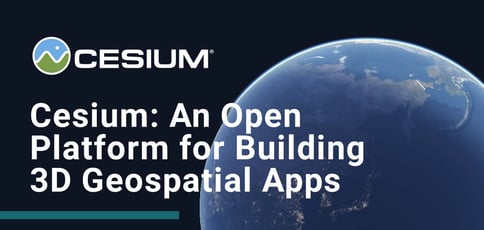
TL; DR: Cesium empowers developers to build robust, flexible 3D applications based on geospatial data. The platform, designed with a commitment to open standards, interoperability, and collaboration, aims to unlock the power of 3D data across industries. Now, with the revolutionary Cesium for Unreal, the company is making it possible to bring game engine technology into the geospatial data ecosystem.
The average person doesn’t always perceive the construction industry as the most technologically advanced. But that stereotype may soon meet its end.
Cesium’s new partnership with the construction equipment manufacturer Komatsu is one good example of why. The 3D visualization experts are providing Komatsu with the geospatial technology needed to digitally transform its business.
With the help of Cesium, Komatsu Smart Construction will use real-time geolocated data collected from intelligent machines at the network’s edge to create a 3D-rendered replica of construction sites, allowing site managers to see live updates from the site reflected in an interactive virtual model. The simulation makes projects safer and more efficient.
“We work with Komatsu to develop the Smart Construction Dashboard,” said Andie Tursi, Director of Marketing & Communications at Cesium. “It’s basically a digital twin of the construction site.”
With its platform for creating 3D applications, Cesium empowers professionals across a range of industries to realize the potential of highly accurate 3D geospatial data. The company’s founders created a business model for the platform with openness, interoperability, and collaboration in mind.
Cesium’s 3D Tiles format, for example, is an open specification. As a result, numerous software companies, data providers, and developers now use the standard for visualizing 3D data — and that’s exactly what Cesium intended.
The company’s ultimate goal is to help advance the 3D geospatial ecosystem as a whole, not just within Cesium’s boundaries. To that end, the company recently partnered with Unreal Engine, the makers of a 3D game creation platform, to bring the benefits of geospatial technology to the gaming realm.
Roots in Global-Scale Aerospace Visualization
Cesium got its start in 2011 as a project for an aerospace software company known as Analytical Graphics, Inc (AGI). A team of developers led by Patrick Cozzi created CesiumJS, a JavaScript application for visualizing satellites moving in orbit.
“Patrick convinced the company to release CesiumJS under an open-source license in 2012, and from there, its use cases beyond aerospace proliferated along with the availability of 3D geospatial data,” Andie said. “That opened up a whole new world and led to Cesium spinning out from AGI as an independent company in the Summer of 2019.”
Patrick is now the CEO of Cesium and a recognized leader in advancing open standards, open-source software, and collaboration within the geospatial community. While Cesium still has roots in aerospace, the team has expanded to serve customers across industries.

The platform currently offers a variety of open-source tools that can be used to create 3D geospatial applications of all kinds — including those for autonomous vehicles, drones, and smart cities.
Within the foundational open platform is Cesium ion, a scalable solution for optimizing content for streaming as 3D Tiles, hosting that content in the cloud, and streaming it to devices. CesiumJS remains an open-source JavaScript library for accurate 3D visualization on the web.
And developers can use the subscription-based Cesium ion software development kit (SDK) for incorporating advanced analytics into custom apps. Cesium’s 3D Tiling pipelines are available for deployment in on-premises enterprise environments as well.
“Many of our users take advantage of our free community plan, which gives them access to global terrain and imagery and our tiling pipelines that format their data for streaming on the web in personal or academic projects,” Andie said. “We offer commercial plans for companies building custom applications. We occasionally partner with select companies that have a need for digital transformation in their industries to create entirely new applications, like the Smart Construction Dashboard.”
A Dedication to Openness and Accuracy
Cesium’s business platform may be a combination of open-source and commercial software, but the company remains focused on a commitment to open standards.
“3D Tiles, the open standard we created and that our platform is built on, has become the standard format in 3D geospatial data,” Andie said. “We dedicate a lot of volunteer hours to advancing open standards, and that’s a big differentiator for us.”
In addition to 3D Tiles, Cesium assisted in developing glTF, which many think of as the JPG of the 3D world. 3D Tiles uses glTF, and it is widely supported as an efficient open format for real-time rendering. Andie said these and other open standards spark innovation and prevent vendor lock-in.

“We want to integrate with as many different software solutions as possible,” she said. “We’re highly focused on interoperability because collaboration is the best way to drive innovation, and there’s so much innovation that still needs to be done in this relatively brand-new space.”
Cesium was originally named after the chemical element that makes atomic clocks accurate — and accuracy remains a central focus for the company in its current iteration.
“What sets us apart here is the combination of geospatial and computer graphic expertise,” Andie said. “Between his academic life and the books he’s written, our CEO Patrick Cozzi’s focus is on innovation at the intersection of geospatial and computer graphics. These areas of expertise combined with our roots in aerospace speak to the accuracy of Cesium.”
There’s not much room for error in aerospace, and Cesium’s ability to create highly precise digital representations of global locations reflects that.
Cesium for Unreal: Uniting Gaming and Geospatial Tech
One of the team’s most significant priorities at the moment is Cesium for Unreal, a plugin combining game engine innovations (via the Epic Games Unreal Engine) with 3D geospatial technology.
“This plugin is the biggest thing in geospatial right now,” Andie said. “For the first time, developers can bring this fully accurate, full-scale globe into the Unreal Engine to build game experiences with 3D geospatial data.
Developers are already using tools to add detailed real-world visual elements, such as foliage and water, to game engine technology.
“It’s a combination of what game engines are capable of and that visual quality that people have come to expect with the accuracy of geospatial data,” she said. “We’re at the dawn of a new era for geospatial tech. Obviously, we don’t have the data for the entire globe yet. But that’s what’s possible in the future.”

To help advance the state of geospatial technology, Cesium has created an entire department dedicated to emerging technology. Andie said you can often find developers on this team decked out with augmented reality (AR) and virtual reality (VR) headsets in an effort to explore the potential of geospatial technology in computer-simulated environments.
It’s irresistible to make a comparison to Star Trek’s famous holodeck here — and Andie said many people do. The technology is just that futuristic.
“They’re experimenting with AR and VR on their headsets to discover what’s going to be possible in the next couple of years,” Andie said. “We have a demo day every Friday where developers on the Cesium team share what they’re working on. And, consistently, every week, we see something that is just mind-blowing.”
HostingAdvice.com is a free online resource that offers valuable content and comparison services to users. To keep this resource 100% free, we receive compensation from many of the offers listed on the site. Along with key review factors, this compensation may impact how and where products appear across the site (including, for example, the order in which they appear). HostingAdvice.com does not include the entire universe of available offers. Editorial opinions expressed on the site are strictly our own and are not provided, endorsed, or approved by advertisers.
Our site is committed to publishing independent, accurate content guided by strict editorial guidelines. Before articles and reviews are published on our site, they undergo a thorough review process performed by a team of independent editors and subject-matter experts to ensure the content’s accuracy, timeliness, and impartiality. Our editorial team is separate and independent of our site’s advertisers, and the opinions they express on our site are their own. To read more about our team members and their editorial backgrounds, please visit our site’s About page.

